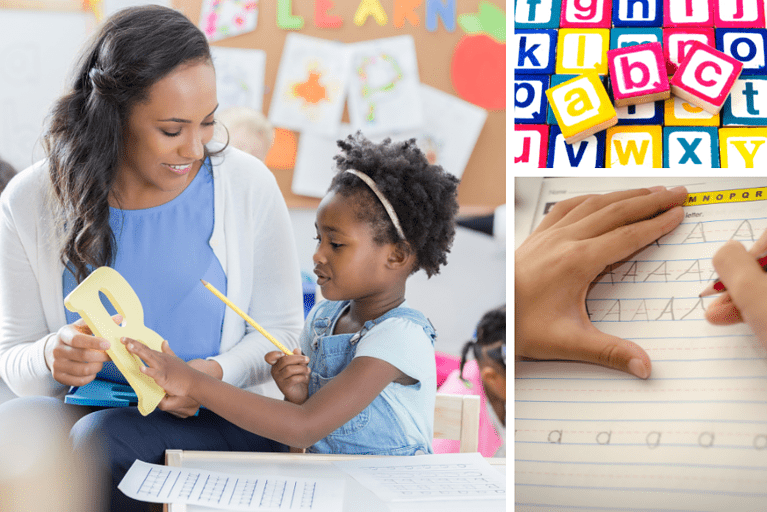This post is all about how to teach digraphs and blends.
If your child is ready to learn about digraphs and blends, it may be time to freshen up your own knowledge of these two phonics skills. Digraphs and blends can often be confused with one another. In this article, let’s talk about how digraphs and blends are different. Some helpful strategies and activities on how to teach blends and digraphs are included as well.
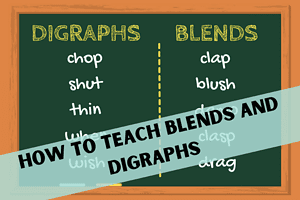
Are you ready? Let’s get to it!
How to Teach DIGRAPHS and BLENDS
What are digRAPHS AND BLENDS?
Let’s talk about blends first, shall we?
Definition of a blend
A blend is when two or more consonants are together, and they each make their own sound.
Example of a consonant blend
Let’s look at this word: slip
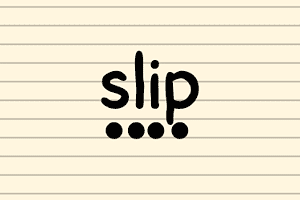
We see that there are 4 letters in the word. I put dots under each sound we hear.
Now, let’s go ahead and mark the vowel with a V.
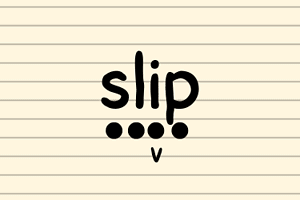
In the beginning of this word, we have two consonants together. Let’s go ahead and put two lines under each consonant. I am only going to do this for the letters that are a part of the blend.
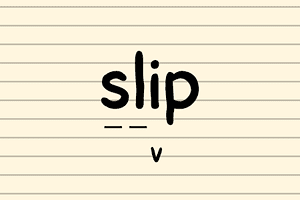
Now, let’s compare this to digraphs.
DEFINITION OF A DIGRAPH
A digraph is when two consonants are next to each other and make one sound.
It is easy to confuse digraphs and blends because they both have two letters.
To figure out if it is a digraph or a blend, just ask, “How many sounds are those two letters making?”
If the two letters are making one sound, it’s a digraph.
And if they are making two sounds, it is a consonant blend.
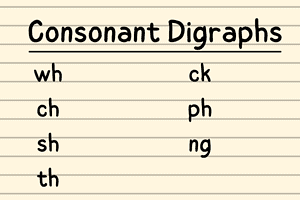
Example of a Digraph
Let’s look at the word below.
Just like the example above, this word has four letters. However, there are only 3 sounds this time!
Let’s put a dot under each sound that we hear.
In the word chip, we hear three sounds: /ch/… /i/… /p/
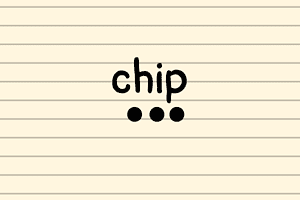
Let’s mark the vowel with a V.
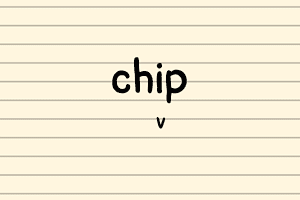
This time let’s underline both of the consonant letters that are next to each other in the beginning. This is the digraph!
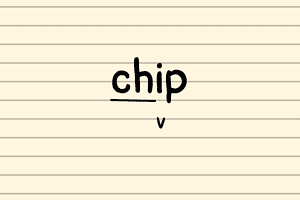
See the difference between these two words?
In the word slip, you hear all four of the sounds in that word.
Slip becomes… /s/… /l/…/i/…/p/
In the word chip, you hear three sounds.
Shop becomes… /ch/… /i/…/p/
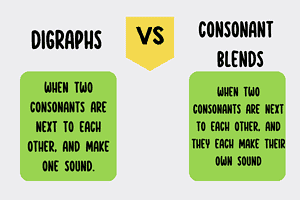
Why we teach blends and dIGRAPHS
The Benefits of teaching blends and digraphs
Why should we directly teach children about blends and digraphs? They will eventually figure it out as they keep reading, right?
Not really…
Let me explain why!
Children need to be taught about blends and digraphs because it helps them become stronger readers. When children learn about these different phonics rules, there are two main things occurring.
- First, your child is learning the different sounds that letters make.
- Then, their brains are connecting how those sounds form words.
This is an important skill because it helps children read unfamiliar words. Learning and understanding these different phonics skills helps your children become better spellers as well.

How TEACHING blends and digraphs help with reading fluency and comprehension
So, we know that phonics is one of the foundational skills of reading. It’s an essential step in learning to read.
When children are taught phonics skills explicitly (that means in a clear, organized way), their general reading skills improve. That ability to look at a word, sound it out, and read it is referred to as decoding.
When you are able to read words, your reading fluency increases. Reading fluency is your ability to read a text quickly, accurately, and with appropriate expression.
With better reading fluency skills, your reading comprehension skills will improve as well. When someone is able to read fluently, they’re able to read quickly. They are able to focus more on the text at hand instead of focusing on sounding out the words.
Because the reading is almost automatic, it leads to better reading comprehension.
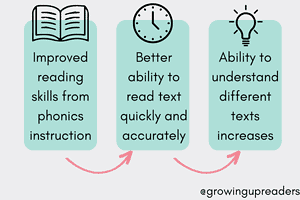
Do you see how it’s like everything has a snowball effect? When you build on those core phonics skills, those other very important reading skills grow as well.
Learning these phonics skills is really important when it comes to reading, but let’s talk about how it relates to spelling as well.
The connection between blends, digraphs, and spelling
When children are learning to read, they are understanding that sounds have letters and different letter combinations.
Learning about blends and digraphs is important for spelling. The reason is that your child will understand that specific sound patterns create words.
For example, let’s think of the two words used above: slip and chip. The word slip contains the blend /sl/ while the word chip contains the digraph /ch/.

Understanding these letter patterns allows us to spell more complicated words.
Teaching Strategies for Blends and Digraphs
How to Introduce Blends and Digraphs
After your child is able to read and spell a variety of CVC (consonant-vowel-consonant) words, I recommend introducing digraphs first. Then you can work on consonant blends.
Here are some tips on how to introduce different blends and digraphs.
START OUT WITH simple words first.
Begin with simple blends and digraphs. Grab a digraph word list here. This website will also have word lists for consonant blends. A great resource to keep handy!
KEEP IT SIMPLE
First, explain what a digraph and a blend are. While you are explaining it, give specific examples by either writing down words or using magnetic letters. See if they can identify the digraph or blend on future words.
TAKE TIME TO PRACTICE
Once your child seems to understand the basics of blends and digraphs, additional practice will be great!
Continue to write down different words from the word list on a dry-erase board or use magnetic letters.
Have your child read the word. Provide support as needed. If your child makes an error, correct it.
Use visual aids (picture clues)
If you think your child is a visual learner, having visual aids while you’re teaching will be so beneficial.
Here is a great picture chart that features the different digraphs and picture clues.
For example, if you find that your child can’t remember what a certain digraph says, take the time and point to the picture clue featured in the chart. You can ask, “What is our picture clue for /sh/?” And they can reply with, “Ship!”
Ask additional questions, such as “What sound is at the beginning of “ship”?”
Those leading questions are SO helpful when you’re teaching these new skills.
Make it multi-sensory
One of the best ways to reinforce these different phonics skills is by incorporating multi-sensory strategies. Multi-sensory means you are using multiple senses (sight, touch, movement) to help learn better.
Some multi-sensory strategies include:
Using a tactile surface to spell out words (shaving cream, sandpaper, etc),
tap out the sounds in the word on the table
Using letter tiles or alphabet magnets
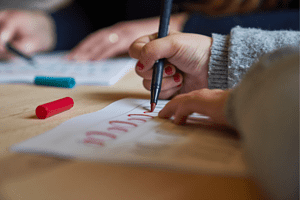
Tips for Support
ONE SKILL AT A TIME
If you find that your child may be struggling with digraphs and blends, I would recommend pulling back a bit. What I mean by that is to reduce the number of new skills introduced.
That means do not introduce all of the digraphs at once. If your child can handle that, great! For many, it will be too overwhelming and confusing.
Instead, introduce one digraph and blend one at a time. Practice that blend and digraph together. Allow opportunities for your child to be independent.
Once your child is comfortable with that specific skill, then you can slowly build on top of that.
Provide plenty of practice
Children need plenty of practice to not only learn a new skill but to master that skill. For our children to become skilled and confident readers, practice really does make perfect.
Give your child plenty of opportunities to read words with blends and digraphs. Have them spell words that contain these blends and digraphs as well.
THE POWER OF PRAISE
Make sure to praise all of your child’s efforts throughout this process. By praising their efforts while they are reading, you can help increase their confidence and motivation to continue to learn.

How to Teach DIGRAPHS and BLENDS
Related Posts:




